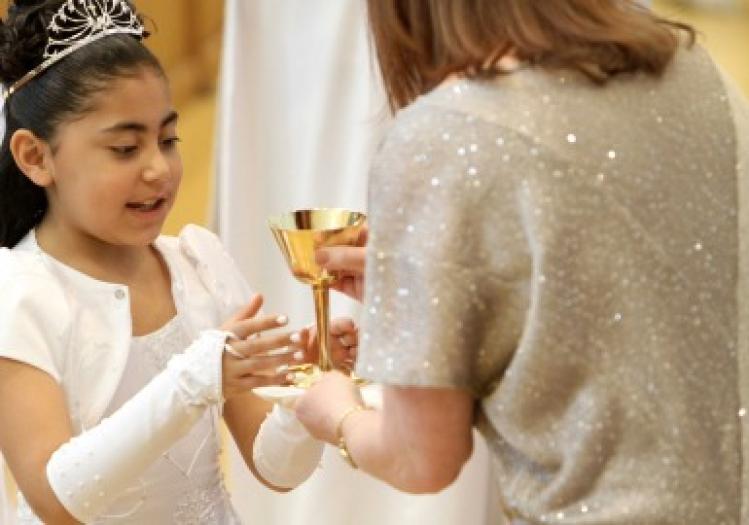
When we were dating as college students in the 1980s, we would occasionally have philosophical discussions about our Catholic faith and about the differences in how our families lived that faith. Peter was at Haverford College, and he was seriously considering leaving the church and becoming a Quaker. Liz was at the College of William and Mary studying religion and history, active in the Catholic Student Association, and fully committed to remaining Catholic. Settling how and where we would worship together if we were to get married and have children was terribly important to us.
We made a decision together (says Liz, who won the debate) to remain in the Catholic Church. Our backgrounds were different, but our Catholic identity ran deep, with Irish-Catholic roots spreading in almost every direction. Liz’s uncle, a Jesuit, and Peter’s cousin, a Franciscan, concelebrated at our wedding. We wanted those roots to be the foundation for our family.
[Editors' note: Go here to see all of the stories we've posted as part of the Raising Catholic Kids symposium.]
We started our two sons in a parochial school when they were kindergarteners, but soon decided to move them to public school. The tipping point came when Liz attended a school Mass on a Marian feast day. The homilist told the children they should be perfect as Mary is perfect. On the way home, Liz asked our first-grader, “What does it mean to be a Christian? Does it mean to be perfect, or to be forgiven?” When our seven-year-old son’s immediate response was “to be perfect,” we knew the school was wrong for him.
Since then, we have home-schooled our three children at certain times in addition to sending them, as appropriate, to public school, a nondenominational Christian school, an all-girls Salesian school, and an all-boys Jesuit school. Through it all, we have sought environments and experiences that help each child grow toward completeness, toward becoming the person he or she was born to be. That, to us, is the essence of raising our kids in the Catholic faith. Our job is to help them find a spiritual home in the church, a home where their individual gifts, disposition, and way of engaging the world are recognized and nurtured. Rather than “be perfect like Mary,” the message we try to pass on to our children is St. Francis de Sales’s encouragement to “be who you are and be that well.”
Aside from weekly Mass, we have tried to make prayer part of our family life. In this regard, the Franciscan, Jesuit, Salesian, and Benedictine spiritual traditions have provided inspiration. Early on, we established a pattern of morning and evening prayer, which admittedly did not always go smoothly—or at all. David Robinson’s book The Family Cloister: Benedictine Wisdom for the Home (Crossroad) helped connect our prayer with the practice of the liturgy of the hours, and identified principles such as hospitality, community, and growth that we wanted to emphasize in our family life. A visit to Assisi brought the Prayer of St. Francis into our home (and his statue into our garden). We offer family prayers and Celtic blessings on first days of school, before trips, before athletic competitions, and when other challenges arise. Liz’s Jesuit uncle celebrates informal home Masses when the extended family gathers, and has done so for fifty years.
We have also made a point of not avoiding difficult doctrinal issues. If, for example, one of the children asked us why the church teaches that Mary was “ever virgin” yet also teaches that within marriage there is a sacramental dimension to sex, we would explain the doctrinal argument for Mary’s perpetual virginity, while also acknowledging that, to us, the idea that Mary remained a virgin does not seem very plausible. We have always been honest about our own doubts, hoping that if our children continued to practice the faith, they would do so thoughtfully and with humility. We wanted them to know that having doubts and questions is not inconsistent with developing a mature faith life. We hoped that by walking them through the arguments, we would be raising children who, in the words of John Paul II, use reason and faith as “the two wings on which the human spirit rises to the contemplation of truth.”
Given our own hesitations, some might ask why we have raised our children as Catholics and not in some other Christian denomination. Why not join a faith community where women can be priests and gay and lesbian people do not need to hide their relationships? Why did we continue in the Catholic Church after the pedophilia crisis revealed that those in authority lacked the basic moral instinct to protect children? Why have we stayed even when the church’s righteous indignation over abortion has too often drowned out other Catholic social teachings that are also rooted in a commitment to the dignity of every person?
We can only offer a classic Catholic response: Faith is a mystery. Whatever the church’s shortcomings—not so different from those of any other religious institution—we want to pass on to our children the Catholic mystical and spiritual tradition. Karl Rahner once said that either Christians of the future will be mystics or they will not exist at all. Raising our children as Catholics has meant hoping they would blend a healthy skepticism with a feeling of being at home in the mystery of the church. Part of that mystery is the frank acknowledgment of the fact that the founders of the spiritual traditions that have nourished our family were also profoundly imperfect people.
Each of our children seems to be identifying with the spiritual traditions that best fit his or her own temperament. For Brian—a twenty-two-year-old who has spent two and a half years away from college traveling, volunteering in the national parks, living in Alaska, and writing—the wisdom of the desert fathers, the simplicity and passion of Franciscans such as Richard Rohr, and the searching social criticism of Thomas Merton have been inspirations. He is not in the pews every week. Instead, he says he plans “to take what’s sacred and worthwhile in the Catholic Church and leave the rest. That probably means I will not be a practicing Catholic. I’ll keep practicing though, practicing something…trying to get somewhere.”
Collin—a twenty-year-old student and distance runner at Georgetown University who is studying biology and theology—has found particularly compelling the Ignatian values of “being men and women for others” and caring for the whole person. He attends Mass and says he continues to “identify as a Catholic.” Each year, he has inspired and sponsored a fellow member of the track team to join the Catholic Church at Georgetown’s Easter vigil.
Nora—a junior at an all-girls Salesian high school that encourages its students to “Live Jesus”—is discovering her gifts and who she will become. She says that because she has had a firm faith-based upbringing, it is second nature for her to look to Catholicism in everyday life: “My faith is especially prevalent when I find myself in a situation where I need to make a difficult decision. As I continue to grow, I will combine my strong personal convictions with the beliefs I have grown up with to create an even stronger, lifelong faith.”
Our hope is that their Catholic spiritual roots run as deep for them as they have for us. Like Karl Rahner, we believe that if our children are to remain in the Catholic Church—or even the Christian tradition—it will be because they have tapped into a particular vein of its mystical and spiritual traditions and made it their own.
[Editors' note: Go here to see all of the stories we've posted as part of the Raising Catholic Kids symposium.]
Please email comments to [email protected] and join the conversation on our Facebook page.
Previous Story
'Learning Humility, Learning Patience'
Next Story
'Not All Religious Learning Happens Explicitly'


